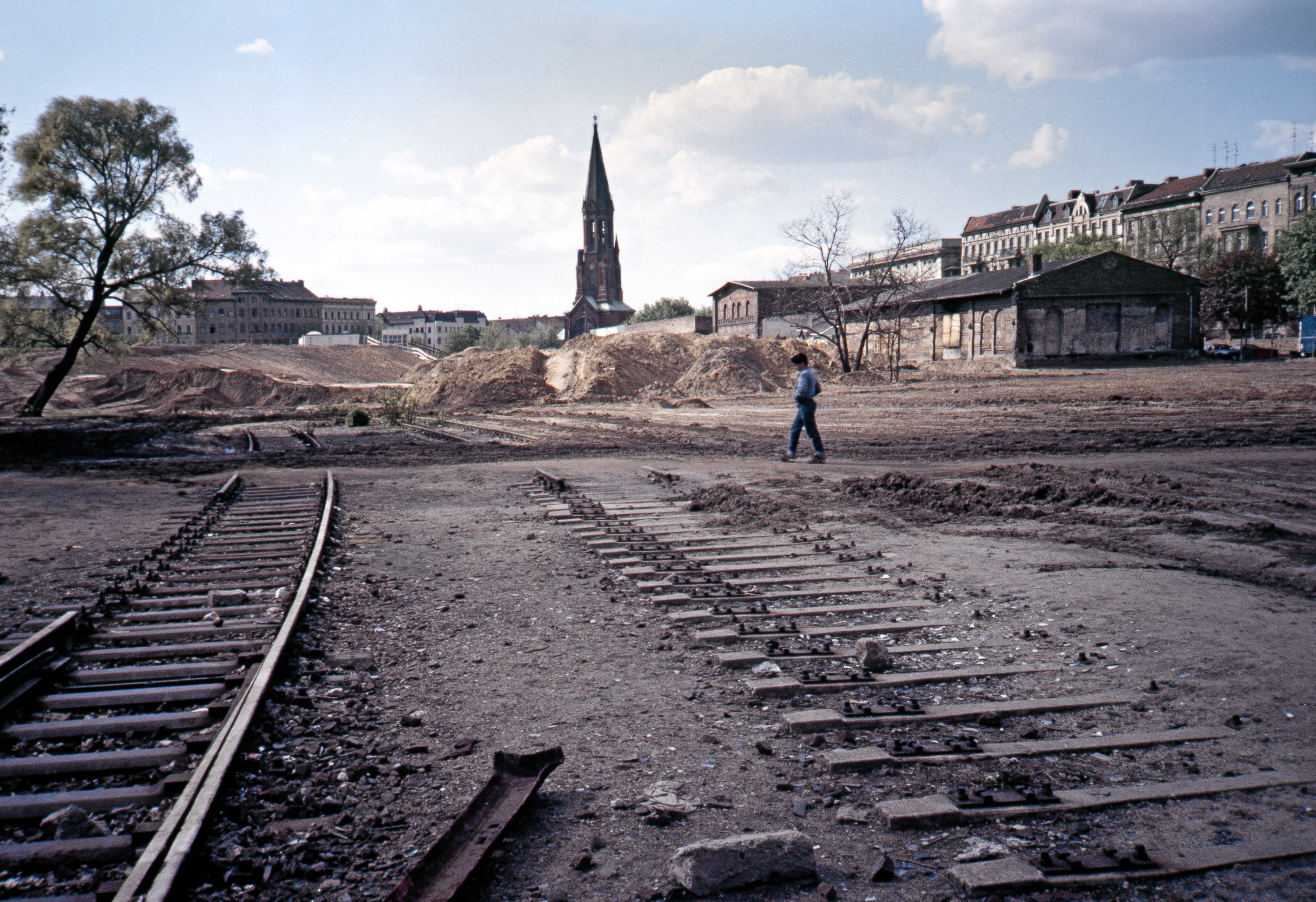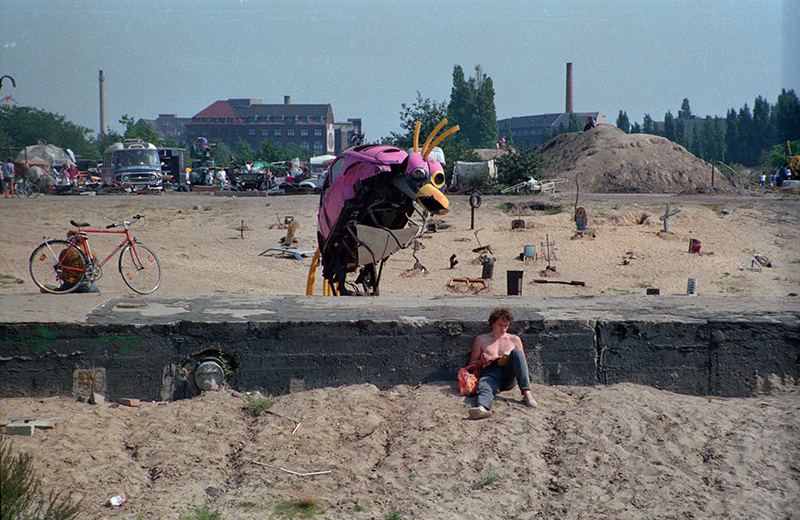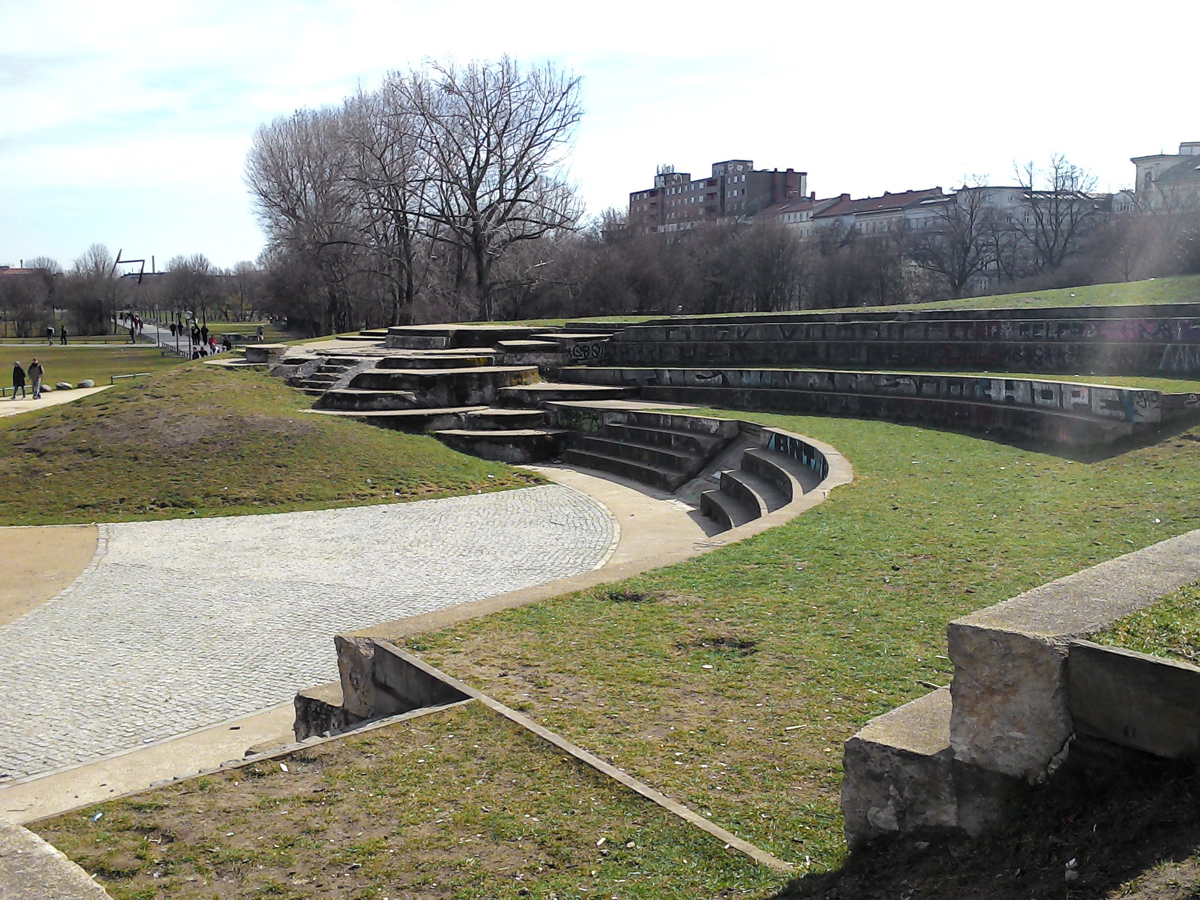Görlitzer Park on:
[Wikipedia]
[Google]
[Amazon]
Görlitzer Park (nicknamed "Görli") is a major park and recreation area in the

 The original Görlitzer Bahnhof (named after the Saxon town of Görlitz) suffered heavy damage during the Battle of Berlin. The last passenger train services to operate through the station ended on April 29, 1951. Demolition of the site took place on 24 October 1962, at the behest of former Berlin Senator, Rolf Schwedler (
The original Görlitzer Bahnhof (named after the Saxon town of Görlitz) suffered heavy damage during the Battle of Berlin. The last passenger train services to operate through the station ended on April 29, 1951. Demolition of the site took place on 24 October 1962, at the behest of former Berlin Senator, Rolf Schwedler (
 At the end of the 1980s, a district park was built on the former railway site to the plans of the Freie Planungsgruppe Berlin. Today, only remnants of tracks, the pedestrian tunnel, the former enclosure wall, and three freight sheds exist of the former station.
In the south of the present park, several railway bridges connected the station area with the district of Treptow, one of which is still preserved, that leads pedestrians over the Landwehr Canal. A green corridor on the former railway line runs parallel to Kiefholzstraße and deep into Alt-Treptow so that cyclists and pedestrians can access
At the end of the 1980s, a district park was built on the former railway site to the plans of the Freie Planungsgruppe Berlin. Today, only remnants of tracks, the pedestrian tunnel, the former enclosure wall, and three freight sheds exist of the former station.
In the south of the present park, several railway bridges connected the station area with the district of Treptow, one of which is still preserved, that leads pedestrians over the Landwehr Canal. A green corridor on the former railway line runs parallel to Kiefholzstraße and deep into Alt-Treptow so that cyclists and pedestrians can access  The Görlitzer Tunnel was still walkable until at least the end of 1989, the removal of which gave the park a large hollow in the middle, which forms a kind of natural arena. The former walls of the tunnel were included as a design element and are still recognizable today. On the west side of the basin is a steel-beam sculpture, ''Schreitender Mensch'', by Rüdiger Preisler.
The Görlitzer Tunnel was still walkable until at least the end of 1989, the removal of which gave the park a large hollow in the middle, which forms a kind of natural arena. The former walls of the tunnel were included as a design element and are still recognizable today. On the west side of the basin is a steel-beam sculpture, ''Schreitender Mensch'', by Rüdiger Preisler.
 The Pamukkale fountain, created by the sculptor Wigand Witting from 1994 to 1997 and completed in 1998, was one of the main design elements in Görlitzer Park. It was inspired by the travertine terraces of Pamukkale,
The Pamukkale fountain, created by the sculptor Wigand Witting from 1994 to 1997 and completed in 1998, was one of the main design elements in Görlitzer Park. It was inspired by the travertine terraces of Pamukkale,  The remaining concrete terraces were laid out with artificial turf and now are used for seating.
After the demolition of the fountain and the dissatisfaction of many park visitors with the condition of the park, the district office of
The remaining concrete terraces were laid out with artificial turf and now are used for seating.
After the demolition of the fountain and the dissatisfaction of many park visitors with the condition of the park, the district office of 
Kreuzberg
Kreuzberg () is a district of Berlin, Germany. It is part of the Friedrichshain-Kreuzberg borough located south of Mitte. During the Cold War era, it was one of the poorest areas of West Berlin, but since German reunification in 1990 it ha ...
district of Berlin
Berlin ( , ) is the capital and List of cities in Germany by population, largest city of Germany by both area and population. Its 3.7 million inhabitants make it the European Union's List of cities in the European Union by population within ci ...
. The 14-hectare park area contains, among other things, a petting zoo
A petting zoo (also called a children's zoo, children's farm, or petting farm) features a combination of domesticated animals and some wild species that are docile enough to touch and feed. In addition to independent petting zoos, many genera ...
, several sports and football fields, and a small lake. At its north-west end is the Görlitzer Bahnhof U-Bahn station.
History

 The original Görlitzer Bahnhof (named after the Saxon town of Görlitz) suffered heavy damage during the Battle of Berlin. The last passenger train services to operate through the station ended on April 29, 1951. Demolition of the site took place on 24 October 1962, at the behest of former Berlin Senator, Rolf Schwedler (
The original Görlitzer Bahnhof (named after the Saxon town of Görlitz) suffered heavy damage during the Battle of Berlin. The last passenger train services to operate through the station ended on April 29, 1951. Demolition of the site took place on 24 October 1962, at the behest of former Berlin Senator, Rolf Schwedler (SPD
The Social Democratic Party of Germany (german: Sozialdemokratische Partei Deutschlands, ; SPD, ) is a centre-left social democratic political party in Germany. It is one of the major parties of contemporary Germany.
Saskia Esken has been t ...
), despite protests by many residents.
In the postwar period, the site was used as a coal depot. Until 1985, freight trains still operated through the Görlitzer Bahnhof train lines, supplying nearby storage sheds and a junkyard on the station grounds. During the division of Berlin, a border crossing was erected on the bridge over the Landwehr canal to control the passage of these freight trains. The remains of this border crossing are still visible today, as are a short piece of track to the east of the canal bridge and two former freight sheds still remain from the former station.
Görlitzer Park is widely known as a hotspot for purchasing cannabis
''Cannabis'' () is a genus of flowering plants in the family Cannabaceae. The number of species within the genus is disputed. Three species may be recognized: '' Cannabis sativa'', '' C. indica'', and '' C. ruderalis''. Alternative ...
.
Park conception
In the early 1980s, a civil and squatter movement began pushing for the creation of a "Görlitzer City Park" on the site of the old Bahnhof. In the spring of 1983, a program of "greening" of the area was scheduled: At this time, the soil at the site of a former scrap metal compactor was heavily contaminated with oil and needed to be replaced, and an area of the future park was still being used as a coal depot. However, theReichsbahn
The ''Deutsche Reichsbahn'', also known as the German National Railway, the German State Railway, German Reich Railway, and the German Imperial Railway, was the German national railway system created after the end of World War I from the regiona ...
management proved to be supportive of the park plans and "Cheerfully developed a children's petting zoo on the southern track. Material and feed donations from surrounding industries flowed in abundantly, and bulldozers from a local cement plant came by occasionally to donate topsoil. Only the money to lease the land was still lacking.
Final approval from the Environment and Finance Senators was still pending at that time.
Children's playground
According to the ''Südost Express'', "the district office of Kreuzberg had already rented the 4000 square meter site," by 1979, as part of the initiative by Verein SO 36, a local civic group. However, the building authorities wanted to use the site to construct a Spreewald-Bad swimming pool complex. "More than 1000 signatures have been collected so far for this playground. ..(After negotiations) the district office will seek to find a solution that makes both the building project and a children's playground possible on the Görlitzer Bahnhof site."The park today
 At the end of the 1980s, a district park was built on the former railway site to the plans of the Freie Planungsgruppe Berlin. Today, only remnants of tracks, the pedestrian tunnel, the former enclosure wall, and three freight sheds exist of the former station.
In the south of the present park, several railway bridges connected the station area with the district of Treptow, one of which is still preserved, that leads pedestrians over the Landwehr Canal. A green corridor on the former railway line runs parallel to Kiefholzstraße and deep into Alt-Treptow so that cyclists and pedestrians can access
At the end of the 1980s, a district park was built on the former railway site to the plans of the Freie Planungsgruppe Berlin. Today, only remnants of tracks, the pedestrian tunnel, the former enclosure wall, and three freight sheds exist of the former station.
In the south of the present park, several railway bridges connected the station area with the district of Treptow, one of which is still preserved, that leads pedestrians over the Landwehr Canal. A green corridor on the former railway line runs parallel to Kiefholzstraße and deep into Alt-Treptow so that cyclists and pedestrians can access Treptower Park
Treptower Park (, with a silent ''w'') is a park alongside the river Spree in Alt-Treptow, in the district of Treptow-Köpenick, south of central Berlin.
History
It was the location of the Great Industrial Exposition of Berlin in 1896. It is ...
through Görlitzer Park. Until the fall of the Wall, the Berlin Wall ran along the Landwehr Canal
The Landwehr Canal (german: Landwehrkanal), is a canal parallel to the Spree river in Berlin, Germany, built between 1845 and 1850 to plans by Peter Joseph Lenné. It connects the upper part of the Spree at the eastern harbour () in Friedri ...
. Also, in the southern part of the area, in the corner formed by Görlitzer Ufer and Wiener Straße, a railroad wheelhouse used to exist. Today, there is a hill with a slide and an toboggan run. The park borders Wrangelkiez on the north/northeastern side.
 The Görlitzer Tunnel was still walkable until at least the end of 1989, the removal of which gave the park a large hollow in the middle, which forms a kind of natural arena. The former walls of the tunnel were included as a design element and are still recognizable today. On the west side of the basin is a steel-beam sculpture, ''Schreitender Mensch'', by Rüdiger Preisler.
The Görlitzer Tunnel was still walkable until at least the end of 1989, the removal of which gave the park a large hollow in the middle, which forms a kind of natural arena. The former walls of the tunnel were included as a design element and are still recognizable today. On the west side of the basin is a steel-beam sculpture, ''Schreitender Mensch'', by Rüdiger Preisler.
Location
The park is bounded to the northwest by Spreewaldplatz, the former station forecourt which now houses the ''Wellenbad am Spreewaldplatz'' swimming pool complex. The swimming pool complex was built between 1984 and 1987 according to plans by architect Christoph Langhof. In the north, Lausitzer Platz flanks the area with the , which was built between 1890 and 1893 according to plans byAugust Orth
August Friedrich Wilhelm Orth (25 July 1828, Windhausen - 11 May 1901, Berlin) was a German architect and designer.
Life and work
He was the son of a manor tenant. In 1834, his family relocated to Korbach. After graduating from secondary scho ...
. They are separated from the park by the viaduct of the Berlin U-Bahn
The Berlin U-Bahn (; short for , "underground railway") is a rapid transit system in Berlin, the capital and largest city of Germany, and a major part of the city's public transport system. Together with the S-Bahn, a network of suburban train li ...
lines U1 & U3 along Skalitzer Straße. In the south, the area borders the Landwehr Canal
The Landwehr Canal (german: Landwehrkanal), is a canal parallel to the Spree river in Berlin, Germany, built between 1845 and 1850 to plans by Peter Joseph Lenné. It connects the upper part of the Spree at the eastern harbour () in Friedri ...
and the district of Alt-Treptow
Alt-Treptow (, literally ''Old Treptow'') is a German locality in the borough of Treptow-Köpenick in Berlin. Known also as Treptow it was, until 2001, the main and the eponymous locality of the former Treptow borough.
History
The locality, first ...
.
Former Pamukkale Fountain and plans for redesigning the park
 The Pamukkale fountain, created by the sculptor Wigand Witting from 1994 to 1997 and completed in 1998, was one of the main design elements in Görlitzer Park. It was inspired by the travertine terraces of Pamukkale,
The Pamukkale fountain, created by the sculptor Wigand Witting from 1994 to 1997 and completed in 1998, was one of the main design elements in Görlitzer Park. It was inspired by the travertine terraces of Pamukkale, Turkey
Turkey ( tr, Türkiye ), officially the Republic of Türkiye ( tr, Türkiye Cumhuriyeti, links=no ), is a transcontinental country located mainly on the Anatolian Peninsula in Western Asia, with a small portion on the Balkan Peninsula in ...
and became a special place of remembrance for the many citizens of Kreuzberg with Turkish ancestry. Due to a faulty substructure and lack of drainage for the foundations, as well as problems with the Portuguese limestone used, the construction was so badly damaged by its first winter that it had to be closed to visitors for security reasons. For a long time, there was a dispute over the restoration. In October 2000, the artist was sentenced to pay damages in the amount of 1.1 million euros. This sentence was confirmed again in November 2008. In autumn 2009, the crumbled fountain construction was removed along with the sculptures that were still intact at the time. The demolition was not without controversy, and led to demonstrations. Unknown activists poured large amounts of red paint down the terraced landscape as a sign of the bleeding out of a significant work of art for the integration and diversity of Berlin's cultures.
 The remaining concrete terraces were laid out with artificial turf and now are used for seating.
After the demolition of the fountain and the dissatisfaction of many park visitors with the condition of the park, the district office of
The remaining concrete terraces were laid out with artificial turf and now are used for seating.
After the demolition of the fountain and the dissatisfaction of many park visitors with the condition of the park, the district office of Friedrichshain-Kreuzberg
Friedrichshain-Kreuzberg () is the second borough of Berlin, formed in 2001 by merging the former East Berlin borough of Friedrichshain and the former West Berlin borough of Kreuzberg. The historic Oberbaum Bridge, formerly a Berlin border c ...
organized an "ideas workshop" in 2009 to beautify the park.

The orchard
Since 2011, in the middle of the park, an orchard with apple, pear and greengage trees was created. In total, there were 26 trees after the third planting in early April 2013. As a memorial to deceased Kreuzberg actor Eralp Uzun, family and friends planted another tree in the meadow in May 2013. This orchard was created by the Kiezwandlern, a localTransition Town
The terms transition town, transition initiative and transition model refer to grassroot community projects that aim to increase self-sufficiency to reduce the potential effects of peak oil, climate destruction, and economic instabilitythrough r ...
group, with the support of the district's green area office. Committed residents habitually cultivate the orchard meadow. The later harvest from the trees is available to the public.
Drug trafficking
Görlitzer Park is one of the largest drug transfer centers in Berlin. The park has been the site of multiple violent incidents resulting in injuries and even death. The drug dealing originated in parts of the park during the 2000s. Since May 2012, the park area has been subject to constant police patrols. The problems, however, have remained. In November 2014, the "Task Force Görlitzer Park" was established to curb drug-related crime around Görlitzer Park. This task force consisted of the Berlin Police, the public prosecutor's office, the administration of justice, the immigration office, and theFriedrichshain-Kreuzberg
Friedrichshain-Kreuzberg () is the second borough of Berlin, formed in 2001 by merging the former East Berlin borough of Friedrichshain and the former West Berlin borough of Kreuzberg. The historic Oberbaum Bridge, formerly a Berlin border c ...
district office. The task force effected several changes to Görlitzer Park, such as removing hedges and shrubs that could serve as drug stashes, as well as greatly increasing the police presence.
Interior Senator Frank Henkel
Frank Henkel (born 16 November 1963) is a German politician of the Christian Democratic Union of Germany, Christian Democratic Union (CDU) who served as a Mayor and Senate of Berlin, Senator of the Interior and Sports of the German state of Berl ...
introduced a zero tolerance
A zero tolerance policy is one which imposes a punishment for every infraction of a stated rule.zero tolerance, n.' (under ''zero, n.''). The Oxford English Dictionary, 2nd Ed. 1989. Retrieved 10 November 2009. Italy, Japan, Singapore China, Indi ...
rule in March 2015 which enabled the police to prosecute consumers and dealers for small amounts of drugs. However, this did not eliminate the drug problem, instead causing many drug dealers to move to other streets, parks and neighborhoods. On October 16, 2017, the Red-Red-Green Coalition rescinded the rule, and the purchase, transportation, and consumption of up to of cannabis in Görlitzer Park has resumed with relative impunity.
References
External links
* {{DEFAULTSORT:Gorlitzer Park Friedrichshain-Kreuzberg Parks in Berlin